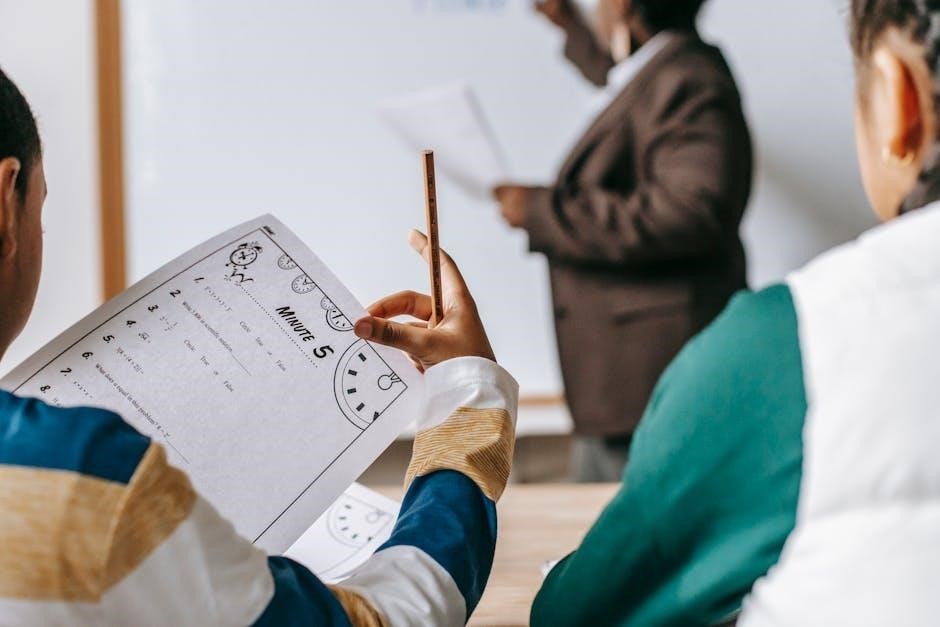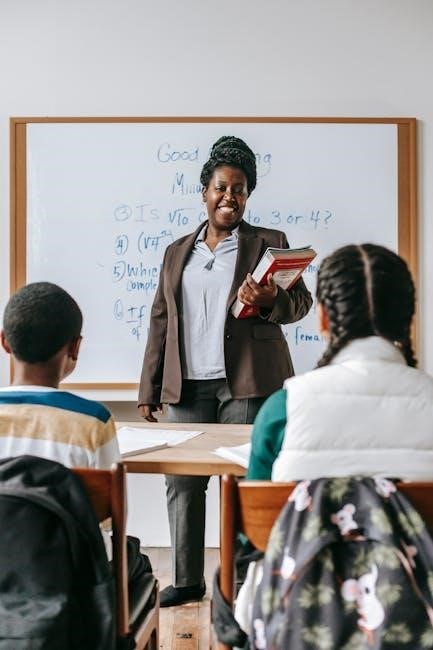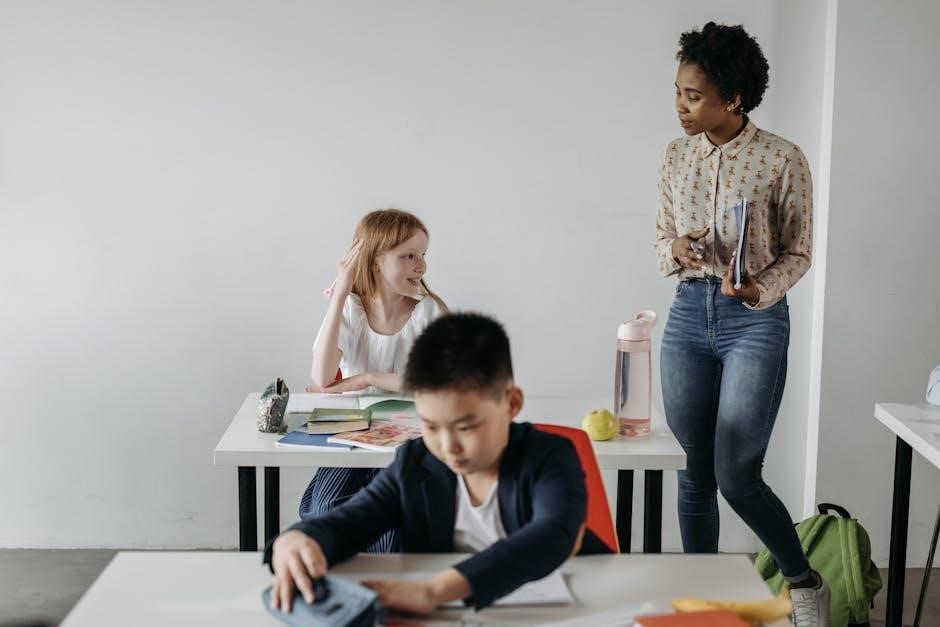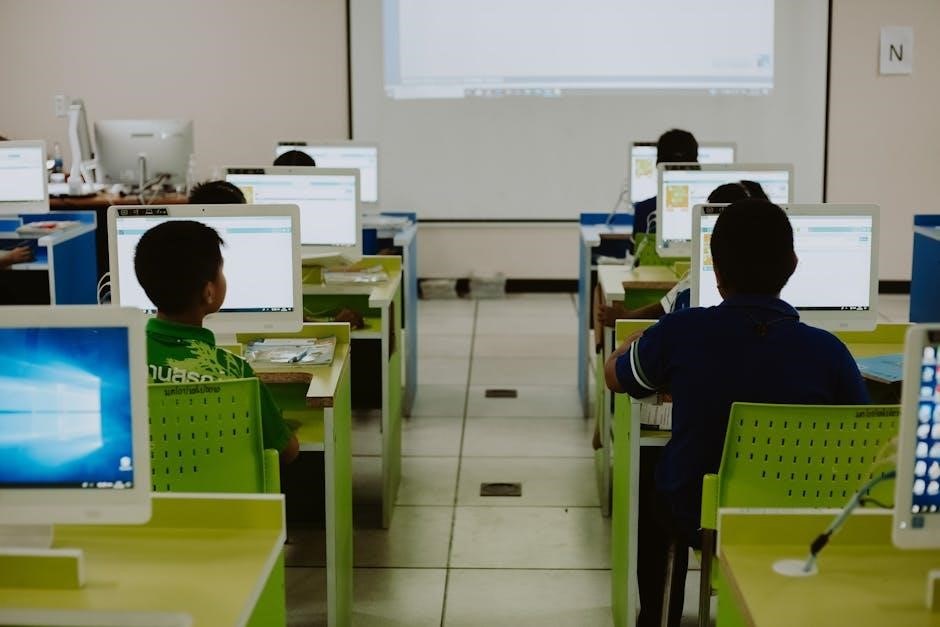The first instruction a teacher delivers sets the foundation for the learning environment. It is a pivotal moment that establishes expectations, engagement, and the tone for future interactions. This initial guidance is crucial for creating a structured and productive classroom atmosphere, ensuring students understand the teacher’s approach and goals from the outset.
Defining the First Instruction
The first instruction of a teacher is the initial guidance or directive provided to students at the beginning of a lesson or course. It serves as the starting point for establishing the learning environment and sets the foundation for how the teacher will interact with students. This instruction is often designed to capture attention, outline expectations, and provide a clear understanding of the lesson’s objectives. It can take many forms, such as a welcome message, a brief overview of the syllabus, or an introductory activity to engage students. The first instruction is crucial because it shapes students’ perceptions of the teacher and the course, influencing their motivation and willingness to participate actively.
Effective first instructions are clear, concise, and relevant to the students’ needs. They often include essential information about classroom rules, learning goals, and the teacher’s approach to instruction. For example, a teacher might begin by explaining the importance of active participation or outlining the key skills students will develop during the course. This initial interaction also provides an opportunity for the teacher to assess students’ prior knowledge and adapt their teaching strategies accordingly. By setting a positive and structured tone, the first instruction plays a significant role in creating an environment conducive to learning and growth.
Possible First Instructions

The first instruction of a teacher can vary widely depending on the educational context, the teacher’s style, and the students’ needs. Common examples include introductory activities, icebreakers, or clear directives to establish classroom expectations. For instance, a teacher might begin by asking students to introduce themselves or share one thing they hope to learn during the course. This approach fosters engagement and sets a collaborative tone.
In some cases, the first instruction might involve a brief overview of the syllabus or classroom rules. For example, a teacher might say, “Please take out a copy of the syllabus and review it with me. We will go over the course objectives and expectations together.” This ensures clarity and alignment from the start.
Other teachers might use interactive activities, such as group discussions or think-pair-share exercises, to immediately involve students. For example, “Write down one question you have about this subject on a piece of paper, and we will address them as a class.” This encourages active participation and curiosity.
The first instruction can also be a practical task, such as setting up materials or organizing notebooks. For instance, “Please open your textbooks to page 12 and follow along as we go through the introduction together.” This helps students develop organizational skills and prepares them for structured learning.
Ultimately, the first instruction is a reflection of the teacher’s approach and the desired classroom environment. Whether it is formal or informal, its purpose is to engage students, establish expectations, and create a foundation for successful learning.

The Purpose Behind the First Instruction
The first instruction serves to create a structured learning environment. It sets expectations, establishes the teacher’s authority, and introduces the classroom culture. This initial guidance helps students understand the rules, routines, and objectives, ensuring a smooth transition into the academic journey. It also fosters engagement and motivation.
Setting the Tone
The first instruction a teacher delivers plays a critical role in setting the tone for the entire academic journey. It establishes the classroom atmosphere, influencing how students perceive the teacher, the subject matter, and their own role in the learning process. A well-crafted first instruction can create a positive, engaging environment, fostering curiosity and motivation;
Clarity and confidence are essential when setting the tone. A teacher who communicates clearly and assertively from the start demonstrates authority and competence, helping students feel secure and guided. Conversely, an unclear or hesitant first instruction may lead to confusion or disengagement.
The tone also reflects the teacher’s personality and teaching style. Enthusiasm, patience, and respect for students can inspire a love for learning, while a rigid or unapproachable demeanor may discourage participation; The first instruction is an opportunity to model the behaviors and attitudes expected in the classroom.

By thoughtfully designing the first instruction, teachers can lay the groundwork for a productive and inclusive learning environment. This initial interaction shapes students’ attitudes and sets the stage for a successful educational experience.
Establishing Expectations
The first instruction a teacher provides is instrumental in establishing expectations, which are the cornerstone of a well-managed and effective learning environment. By clearly communicating expectations from the outset, teachers set the stage for student behavior, academic focus, and overall classroom dynamics. Expectations encompass not only academic performance but also social behavior, respect, and participation.
One of the primary ways teachers establish expectations is through explicit communication. This can include discussing classroom rules, academic goals, and the importance of active engagement. For instance, a teacher might outline specific behaviors, such as raising hands to speak or respecting others’ opinions, to foster a respectful and orderly atmosphere. Similarly, academic expectations might involve explaining the importance of completing homework, participating in discussions, or meeting deadlines.
Clear expectations help students understand what is required of them and how they can succeed. They also enable teachers to maintain consistency and fairness in managing the classroom. When expectations are well-defined, students are more likely to stay focused, motivated, and accountable for their learning. Additionally, establishing expectations early on reduces the likelihood of misbehavior or confusion, creating a more conducive environment for teaching and learning.

Consideration of Educational Levels
The first instruction must be tailored to the educational level of students. For elementary school, it often focuses on basic skills and establishing routines. In high school, the emphasis shifts to complex concepts and fostering independent learning. Teachers adapt their approach to meet the developmental needs of their students effectively.
Elementary School
The first instruction in an elementary school setting is crucial as it sets the stage for the entire academic year. Teachers often begin by establishing clear routines and expectations, ensuring young students feel secure and understand classroom dynamics. This initial guidance typically involves introducing basic rules, such as raising hands to speak or respecting shared materials. Additionally, teachers may incorporate engaging activities or icebreakers to foster a sense of community and excitement for learning.
At this level, the first instruction also focuses on assessing students’ prior knowledge and skills. Teachers might use simple, open-ended questions or visual aids to gauge what students already know about a subject. This approach helps tailor lessons to meet their needs and abilities. Furthermore, educators often introduce foundational concepts through hands-on activities or storytelling, making complex ideas more accessible and relatable for young minds.
The first instruction in elementary school is also an opportunity to model positive behaviors and attitudes toward learning. Teachers emphasize curiosity, collaboration, and perseverance, laying the groundwork for a growth mindset. By combining structure with creativity, the first instruction creates a nurturing environment where students can thrive academically and socially. This thoughtful approach ensures that the initial lesson is both informative and engaging, setting a positive tone for the year ahead.
High School
The first instruction in a high school setting is a critical moment that sets the tone for the entire course. Teachers typically begin by outlining clear academic expectations and establishing a structured learning environment. This initial interaction often involves introducing the syllabus, discussing classroom policies, and emphasizing the importance of active participation and responsibility.
High school instructors also use the first instruction to gauge students’ prior knowledge and skills, which helps in tailoring lessons to meet their needs. Diagnostic assessments or informal discussions about learning objectives are common practices. Additionally, teachers often introduce key concepts or themes that will be explored throughout the course, providing a roadmap for students to follow.
The first instruction in high school is also an opportunity to foster critical thinking and independence. Teachers may assign introductory activities that encourage students to reflect on their learning goals or explore real-world applications of the subject matter. This approach helps students connect theoretical knowledge with practical skills, preparing them for future challenges.
Moreover, the first instruction often includes guidance on effective study habits, time management, and the use of resources such as textbooks, online platforms, or library materials. Teachers aim to equip students with the tools they need to succeed, ensuring they are well-prepared for the academic demands ahead. By combining clear expectations with engaging activities, the first instruction in high school lays a strong foundation for a productive and meaningful learning experience.

Cultural Influences on First Instructions
Cultural influences shape the approach teachers take when delivering their first instruction. In some cultures, a formal, authoritarian style is prevalent, while others emphasize collaborative and inclusive methods. These differences reflect societal values and expectations, impacting how teachers engage with students and set the tone for learning. Universal goals, however, remain consistent.
Diverse Practices
The first instruction of a teacher can vary significantly across cultures and educational systems, reflecting diverse practices shaped by societal norms and pedagogical traditions. In some classrooms, the first instruction might involve an icebreaker activity to build rapport, while in others, it could be a direct lecture to establish authority. For instance, in many Western educational settings, teachers often begin with collaborative activities or discussions to foster engagement and inclusivity. In contrast, in some Eastern cultures, the first instruction might emphasize respect for hierarchy, with students expected to listen attentively and follow directives without question.
Technology also plays a role in shaping these practices. In some regions, teachers might use digital tools to deliver their first instruction, such as interactive presentations or online quizzes, to gauge students’ prior knowledge. In other areas, the focus might be on traditional methods, like reading aloud from a textbook or writing on a blackboard. These differences highlight the adaptability of teaching strategies to fit local contexts and resources.

Ultimately, while the specific practices may differ, the underlying goal remains consistent: to create an environment conducive to learning and mutual understanding. By tailoring their first instruction to the unique needs and expectations of their students, teachers can set the stage for a successful academic journey.
Universal Goals
Despite the diversity in practices, the first instruction of a teacher is often guided by universal goals that transcend cultural and educational boundaries. These goals are rooted in the fundamental principles of education and are designed to create a supportive and effective learning environment.
One universal goal is to foster engagement and curiosity among students. Teachers aim to capture students’ attention from the outset, ensuring they are motivated to participate and learn. This is often achieved through clear communication, relatable examples, or interactive activities that spark interest.
Another universal goal is to establish a sense of structure and routine. The first instruction often includes an overview of expectations, classroom rules, or the syllabus, helping students understand what is required of them. This clarity provides a foundation for accountability and helps students feel secure in their learning environment.
Additionally, teachers strive to create an inclusive atmosphere where all students feel valued and respected. This involves addressing individual needs, encouraging collaboration, and promoting a growth mindset. By doing so, teachers aim to empower students to take ownership of their learning and develop confidence in their abilities.
Ultimately, the universal goals of the first instruction are to inspire, guide, and prepare students for the academic journey ahead. These objectives remain consistent across different teaching styles and cultural contexts, ensuring that education remains a transformative and enriching experience for all learners.

Research and Effective Practices
Research highlights the importance of effective first instructions in shaping student behavior and academic outcomes. Studies show that clear, structured, and engaging initial guidance fosters positive classroom dynamics and improves learning retention. Teachers who incorporate interactive activities and explicit expectations often see higher levels of student engagement and accountability.

Impact on Student Behavior
The first instruction a teacher delivers significantly influences student behavior by setting the tone for the learning environment. A well-structured and engaging introduction can enhance motivation and focus, while a disorganized start may lead to misbehavior. Clear expectations and enthusiasm foster a positive classroom atmosphere, encouraging students to participate and engage actively.

The first instruction a teacher gives is a cornerstone of effective education. It shapes the classroom environment, establishes expectations, and influences student behavior. A well-crafted introduction ensures a productive and engaging learning experience, setting the stage for future success. This foundational moment remains vital in fostering a positive educational journey.
The first instruction a teacher provides plays a critical role in shaping the classroom environment and student engagement. Research indicates that this initial interaction sets the tone for future learning, influencing both student behavior and academic outcomes. Studies highlight the importance of clarity, consistency, and adaptability in delivering this instruction.
At the elementary level, the first instruction often focuses on establishing routines and building trust, while at the high school level, it emphasizes clear expectations and academic goals. Cultural influences also shape these practices, with diverse methods employed globally, yet all aiming to create a positive learning atmosphere.
Findings further reveal that effective first instructions often incorporate interactive elements, such as open-ended questions or thinking routines, to encourage active participation. These strategies not only enhance student understanding but also foster a sense of community within the classroom.
Final Thoughts
The first instruction a teacher delivers is a cornerstone of effective education, setting the stage for a productive and engaging learning experience. It not only establishes expectations but also fosters a sense of trust and mutual respect between the teacher and students. Research underscores the importance of adaptability in this initial interaction, as it must cater to diverse learning needs and cultural backgrounds.
Teachers who craft their first instruction with intentionality often see improved student engagement and academic outcomes. By incorporating interactive elements, such as open-ended questions or thinking routines, educators can create an environment where students feel encouraged to participate and think critically. This approach not only enhances understanding but also nurtures a love for learning.
Ultimately, the first instruction is more than just a starting point—it’s a catalyst for growth. When executed thoughtfully, it can inspire students to embrace challenges, explore new ideas, and develop a mindset that values education as a lifelong journey. By prioritizing clarity, empathy, and innovation, teachers can ensure their first instruction leaves a lasting, positive impact on their students.



